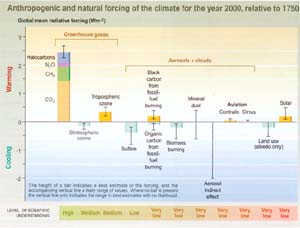| 2.6
|
An increasing body of observations
gives a collective picture of a warming world and other changes in the
climate system (see Table 2-1).
|
|
| |
The global average surface temperature has increased
from the 1860s to the year 2000, the period of instrumental record.
Over the 20th century this increase was 0.6°C with a very likely
(see Box 2-1) confidence
range of 0.4-0.8°C (see Figure
2-3).It is very likely that the 1990s was the warmest decade, and
1998 the warmest year, of the instrumental record. Extending the instrumental
record with proxy data for the Northern Hemisphere indicates that over
the past 1,000 years the 20th century increase in temperature is likely
to have been the largest of any century, and the 1990s was likely the
warmest decade (see Figure 2-3).
Insufficient data are available in the Southern Hemisphere prior to
the year 1860 to compare the recent warming with changes over the last
1,000 years. Since the year 1950, the increase in sea surface temperature
is about half that of the mean land surface air temperature. During
this period the nighttime daily minimum temperatures over land have
increased on average by about 0.2°C per decade, about twice the
corresponding rate of increase in daytime maximum air temperatures.
These climate changes have lengthened the frost-free season in many
mid- and high-latitude regions.
|
 WGI TAR SPM & WGI
TAR Sections 2.2.2, 2.3.2,
& 2.7.2
WGI TAR SPM & WGI
TAR Sections 2.2.2, 2.3.2,
& 2.7.2 |
|
Figure 2-1: Records of past changes in atmospheric composition over
the last millennium demonstrate the rapid rise in greenhouse gases and sulfate
aerosols that is attributable primarily to industrial growth since 1750.
The top three panels show increasing atmospheric concentrations of carbon
dioxide (CO2), methane (CH4), and nitrous oxide (N2O)
over the past 1,000 years. Early sporadic data taken from air trapped in
ice (symbols) matches up with continuous atmospheric observations from recent
decades (solid lines). These gases are well mixed in the atmosphere, and
their concentrations reflect emissions from sources throughout the globe.
The estimated positive radiative forcing from these gases is indicated on
the righthand scale. The lowest panel shows the concentration of sulfate
in ice cores from Greenland (shown by lines for three different cores) from
which the episodic effects of volcanic eruptions have been removed. Sulfate
aerosols form from sulfur dioxide (SO2) emissions, deposit readily
at the surface, and are not well mixed in the atmosphere. Specifically,
the increase in sulfate deposited at Greenland is attributed to SO2
emissions from the U.S. and Europe (shown as symbols), and both show a decline
in recent decades. Sulfate aerosols produce negative radiative forcing.
|
 WGI TAR Figures SPM 2,
3-2b, 4-1a,
4-1b, 4-2,
& 5 4a
WGI TAR Figures SPM 2,
3-2b, 4-1a,
4-1b, 4-2,
& 5 4a |
|
Figure 2-2: The influence of external factors on climate can be
broadly compared using the concept of radiative forcing. These
radiative forcings arise from changes in the atmospheric composition, alteration
of surface reflectance by land use, and variation in the output of the sun.
Except for solar variation, some form of human activity is linked to each.
The rectangular bars represent estimates of the contributions of these forcings,
some of which yield warming and some cooling. Forcing due to episodic volcanic
events, which lead to a negative forcing lasting only for a few years, is
not shown. The indirect effect of aerosols shown is their effect on the
size and number of cloud droplets. A second indirect effect of aerosols
on clouds, namely their effect on cloud lifetime, which would also lead
to a negative forcing, is not shown. Effects of aviation on greenhouse gases
are included in the individual bars. The vertical line about the rectangular
bars indicates a range of estimates, guided by the spread in the published
values of the forcings and physical understanding. Some of the forcings
possess a much greater degree of certainty than others. A vertical line
without a rectangular bar denotes a forcing for which no best estimate can
be given owing to large uncertainties. The overall level of scientific understanding
for each forcing varies considerably, as noted. Some of the radiative forcing
agents are well mixed over the globe, such as CO2, thereby perturbing
the global heat balance. Others represent perturbations with stronger regional
signatures because of their spatial distribution, such as aerosols. Radiative
forcing continues to be a useful tool to estimate, to a first order, the
relative climate impacts such as the relative global mean surface temperature
response due to radiatively induced perturbations, but these global mean
forcing estimates are not necessarily indicators of the detailed aspects
of the potential climate responses (e.g., regional climate change). |
 WGI TAR SPM, WGI
TAR Chapter 6 ES, & WGI
TAR Figures SPM-3 & 6-6
WGI TAR SPM, WGI
TAR Chapter 6 ES, & WGI
TAR Figures SPM-3 & 6-6 |

